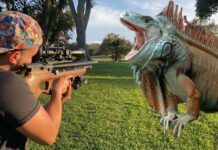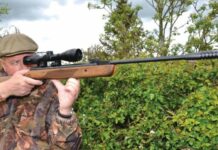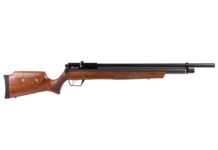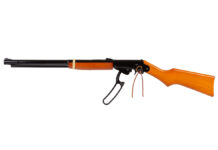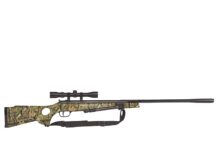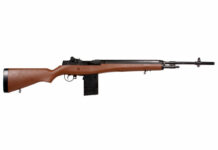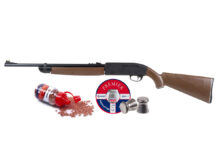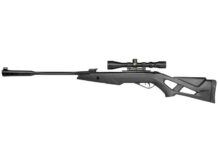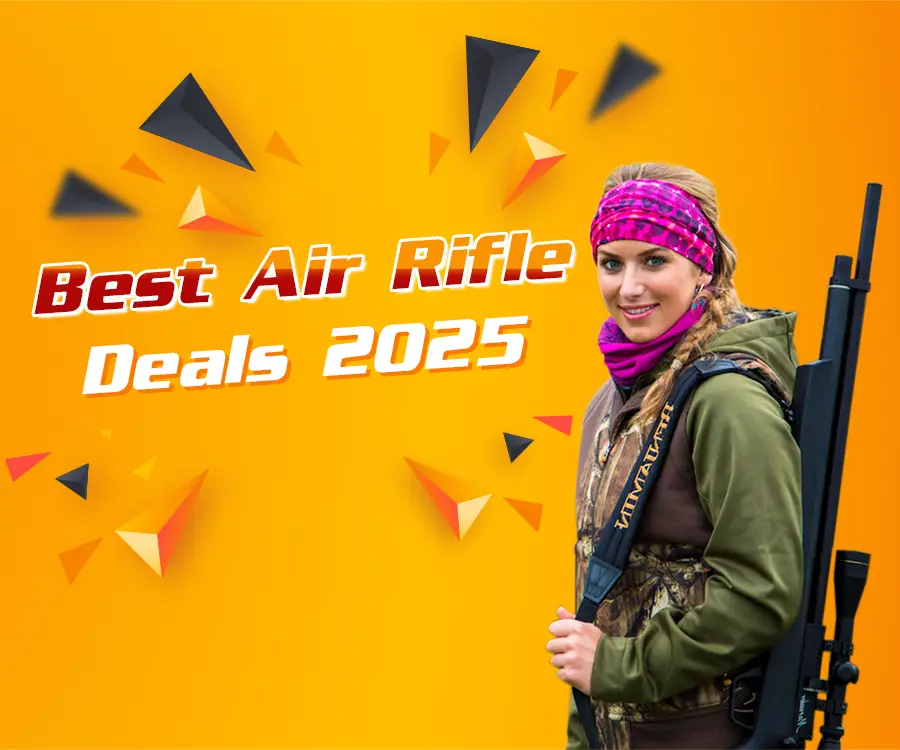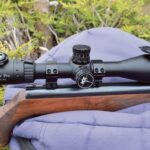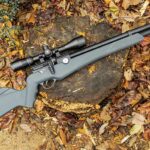Over the past few weeks, I surveyed over 100 shooters who competed in this year’s Nightforce Extended Long Range Steel Challenge in Wyoming. I know a lot of you had questions about calibers, scopes and other gear guys were using, so I put together a survey, and the match director, Scott Satterlee, sent it to all the competitors. Over 100 shooters completed the survey, including 85% of the guys who finished in the top 25 overall. Thanks to all the guys who took the time to share.
One of the fun things about the NF ELR match is it has less established paths to success than most rifle matches. In most PRS/NRL style matches, it’s very likely the guy who wins was using a 6 Dasher (or other 6BR based case), 6mm Creedmoor, or maybe a 6×47 Lapua or 6XC, which are all very, very similar in the grand scheme of things (see the data). In many Extreme Long Range matches the winner is likely using some variety of a 375 CheyTac or 416 Barrett (see the data). This Wyoming match that Scott has designed is one of a kind, featuring features targets from 700-2100 yards in a wide range of scenarios and conditions. (Learn more about the Nightforce ELR match)
While there aren’t formal definitions that anyone agrees on, those distances are further than what most people think of as “traditional” long-range (average target distance at this year’s match was 1,180 yards), but also shorter distance than what many consider “extreme” long-range (90% of the targets at this year’s match were 1500 yards or less). Scott calls this “Extended Long Range,” which is somewhere between the two. As competitors, we’re still trying to figure out what works best, which makes cartridge and equipment choices much more interesting.
“This information will be super helpful to a lot of folks that want to get into the extended range type of engagements,” explained Scott Satterlee. “The Nightforce match is unique to our sport because we had calibers from 6mm through 416’s and everything in between.”
I agree, so let’s dive into the data!
Table of Contents
Most Popular Caliber at the Nightforce ELR Match
Let’s start by looking at the calibers guys chose to run, and then we’ll dive into the specific cartridges they pick. While many shooters use the term caliber and cartridge interchangeably, when I say “caliber” I’m referring to the bore diameter of the barrel (e.g. 30 caliber) and when I say “cartridge” I’m referring to the specific type of case the barrel is chambered for (e.g. 300 Norma Mag, 300 PRC).
The chart below shows a breakdown of the total number of shooters who completed the survey grouped by the caliber they were using. I wanted to also provide context for where those shooters finished in the overall standings, so the colors in each bar is used to segment how high up they finished on the leader board. Black indicates those who finished in the top 10, blue indicates 11th and 25th, green indicates 26th to 50th, yellow indicates 51st to 99th, and light gray indicates 100th to 191st.
Like Scott mentioned, there were literally shooters running 6mm to 416 caliber rifles. However, you can clearly see in the chart above that the majority of shooters were running one of these calibers: 6.5mm, 7mm, or 30 caliber. In fact, those three calibers combine to represent 80% of the surveyed shooters!
You can also see above that some guys finished in the top 25 with 6mm and a 25 caliber rifles, and there was also one shooter who finished in the top 10 with a 338 caliber rifle. Having six calibers represented among the top 25 shooters just shows how many opinions there are in terms of what is optimal for these distances!
Now let’s filter down to just show what caliber guys the guys who finished in the top 50 chose to compete with this year. I know a few very well respected shooters that have competed at the highest levels that finished outside of the top 50 at this match, so its safe to say the guys who finished in the top 50 are all exceptional shooters. Let’s see what those guys chose to run:
The chart above shows that more shooters were running a 6.5mm cartridge in the top 50 than any other caliber. However, more shooters were running a 30 caliber cartridge in the top 10 and the top 25 than any other caliber. But, once again the 6.5mm, 7mm, and 30 calibers were the top picks, with those three combining to represent 81% of the surveyed shooters who finished in the top 50.
Most Popular ELR Cartridges
Now let’s look at the specific cartridges these shooters were using to engage targets from 700-2100 yards … in sustained winds up to 35 mph and wind gusts measured on-site up to 60 mph!
You can see a huge range of cartridges, including the 338 Lapua Mag, and precision cartridges like the 6.5 Creedmoor, 6 Creedmoor, and 6.5×47 Lapua, and larger cartridges like a 7mm Rem Mag, 6.5-284, and even the 28 Nosler. But, 5 cartridges seemed to be most popular, with several people using each of these:
- 6.5 PRC
- 300 Norma Mag
- 300 PRC
- 7 SAUM
- 6.5 SAUM
Those 5 cartridges represented 44% of the 100+ shooters surveyed.
6.5 PRC
The most popular choice among the 100+ shooters surveyed was the 6.5 PRC, which is a new cartridge Hornady released in 2017. The 6.5 PRC had been SAAMI approved for less than two years before this match, which is a short amount of time to already see such widespread adoption among the precision rifle community.
The 6.5 PRC is the big brother to the very popular 6.5 Creedmoor and offers up to 10% more velocity while still maintaining relatively low recoil. PRC stands for Precision Rifle Cartridge, and it was designed from the ground up with this kind of precision shooting in mind. The 6.5 PRC is a compact, magnum cartridge that can drive bullets like the 147 gr. ELD-M 200+ fps faster than the Creedmoor, which allows it to stretch well beyond 1,000 yards. Like the 6mm Creedmoor and 6.5 Creedmoor, Hornady offers high quality, match-grade ammunition for the 6.5 PRC at affordable prices. I noticed at least a couple of shooters at this match using Hornady 6.5 PRC factory match ammo.
Among those surveyed, it seems like most shooters were using their 6.5 PRC to push 144-147 gr. bullets around 2950 to 2980 fps, which should give context for the class of ballistics the 6.5 PRC provides.
300 Norma Mag
The 300 Norma Mag has been popular at this match for the past few years. It’s worth noting that the shooters who finished in the top 4 spots overall in 2020 were all using a 300 Norma Mag. The winners of this Wyoming ELR Match in 2017 and 2018 were both using a 300 Norma Mag, too. I’ve talked about this cartridge extensively in my previous posts, so I won’t cover all that again. Note: This is different than the older 308 Norma Mag, which was designed in 1959. The 300 Norma Mag is a larger and more modern cartridge designed in 2012.
The 300 Norma Mag is a large magnum cartridge that has been adopted by USSOCOM, so it’s popularity continues to rise. With heavy-for-caliber bullets from 215 to 230 gr., it’s ballistics rival that of the 338 Lapua Mag, but with less recoil (although faster barrel wear). USSOCOM’s Advanced Sniper Rifle (ASR) solicitation specified the 300 Norma Mag as one of the cartridges that rifle should be chambered in, and now there are lots of rifles being chambered for that cartridge.
Another big attraction for the 300 Norma Mag is that Lapua is now selling brass for it, which means you can get the best of class brass for it if you need extreme consistency and low variation in muzzle velocity. That is an important thing in this game! (Read more on the 300 Norma Mag)
Among those surveyed, many shooters were running 215-220 gr. bullets around 2980-3000 fps, and 230 gr. bullets around 2940-2970 fps. Jorge took 1st place overall and he said using a 30-inch barrel to push Berger 220 gr. Long Range Hybrid bullet at 2980 fps – with an SD of 2 fps!
300 PRC
The 300 PRC was also very popular among this group. It was released around the same time as the 6.5 PRC, so it’s a bit surprising to see how many precision rifle competitors have adopted it – but there is a lot to like! The 300 PRC was tested and selected by the US Dept. of Defense to use in its extended long-range sniping program.
Long-range expert and former special ops sniper, Ryan Cleckner, explains, “The 300 Norma handily beats the 300 PRC on ballistic performance. This is because it can shoot the same or similar bullet faster. However, this comes at a cost. The 300 Norma requires the same XL-sized action as the 338 Lapua Mag because of its large cartridge case and it recoils more than the 300 PRC.” The XL-sized action is due to the Norma being a “fatter” cartridge, requiring a larger bolt face.
The 300 Norma Mag has slightly more case volume, so it shouldn’t be a surprise that it can provide slightly higher muzzle velocities and a small edge in ballistics. In my survey, some shooters using a 300 Norma Mag were pushing 230 gr. bullets around 2960 fps, while shooters using a 300 PRC said they were pushing 230 gr. bullets around 2860 fps. So the 300 Norma Mag can provide roughly 100 fps faster velocities than the 300 PRC, which is more but not a drastic difference.
With the overall length of 3.7 inches, the 300 PRC requires a magnum length action. You can use it with a Remington 700 Long Action, but it requires a few modifications. Some also believe the 300 PRC addresses other drawbacks of the 300 Norma Mag, but I’ll side-step that debate. After reading a ton about both and personally talking to experts closely involved with their designs, I don’t think one is inherently better than the other. Clearly, there are good shooters using each one effectively, so it likely comes down to your particular application and personal preferences.
7 SAUM
There were also several shooters using the 7mm SAUM, also known as the 7mm Remington Short Action Ultra Mag, including one in the top 10 and another in the top 25. The 7 SAUM is a short-action, magnum cartridges similar to the 7 WSM. One of the draws to the 7 SAUM is the availability of high-quality brass through companies like Norma and ADG. The 7 SAUM offers better performance than the 300 Win Mag in a package that is almost as small as the 6.5 Creedmoor. I read a great article written by nationally-ranked precision rifle competitor, Caylen Wojcik, that walks through how he landed on the 7mm SAUM cartridge for a dual-purpose rifle build to use in extended long-range competitions and long-range hunting. Caylen said he runs 180 gr. bullets around 2900 fps with his 7 SAUM. Lou Smith finished in the top 10 with a 7 SAUM in the Wyoming ELR match, and he was running Berger 184 gr. Hybrid bullets at 2930 fps from his 30-inch barrel.
Honestly, with so many guys using either a 6.5mm or a 30 caliber, it seems like the 7mm could prove to be the happy medium. I talked with Scott Satterlee about this a couple of years ago and we both believe some flavor of 7mm magnum could arguably be the ideal choice for this match. Now with the release of 7mm bullets like Hornady’s 190 gr. A-Tip, and Berger’s new 190 gr. Long Range Hybrid Target (LRHT) bullet – I would be surprised if we don’t see more 7mm magnums in the future. Cartridge choice follows bullet design, so when new bullets are released you can always expect it to disrupt cartridge popularity as new bullet designs open new opportunities.
6.5 SAUM
Finally, several shooters chose to run a 6.5 SAUM at the Nightforce ELR Steel Challenge, which is obviously very similar to the 7 SAUM, but necked down to a 6.5mm bullet. If you just look at what the shooters who finished in the top 25 were using, there were as many running a 6.5 SAUM as any other cartridge! The 6.5 SAUM and the 300 Norma both had 4 shooters represented among the top 25. The 6.5 SAUM had two shooters represented among the top 10 and two other shooters in the top 25.
The shooter highest on the leaderboard that was using a 6.5 SAUM was Carson Rutherford, who placed 5th overall. Carson said he was using Hornady 153 gr. A-Tip bullets, and was pushing those at 3,090 fps with an SD of 6 fps. The shooters surveyed that were using a 6.5 SAUM reported a variety of velocities, but many of those who finished in the top half were pushing 140-147 gr. bullets 3090 to 3115 fps.
Here is a closer look at the cartridges used by those who finished in the top 25 at the 2020 Nightforce ELR Steel Challenge:
First, it is interesting that while the 6.5 PRC was the most popular cartridge among these 100+ shooters surveyed, nobody finished in the top 25 with a 6.5 PRC. The highest finishes were 26th, 39th, and 47th, so it wasn’t far off. I can’t help but wonder if the combination of the extended target distances and the 20-35 mph winds were a little too much for that smaller magnum cartridge. Of course, “correlation does not imply causation,” meaning the fact that those shooters were using a 6.5 PRC and didn’t land in the top 25 doesn’t mean their cartridge choice caused them to finish where they did. In fact, one of the guys who finished in the top 10 was using a 6.5×47 Lapua, which has less ballistic performance than the 6.5 PRC (and is extremely impressive!), so there is probably more going on here than raw ballistic performance. Knowing the 6.5 PRC is a relatively new cartridge, another plausible theory might be that some of the guys who just got into this style of shooting had their new rifles chambered in that cartridge, and maybe that represents a large segment of those using a 6.5 PRC. Either way, it is interesting there were no 6.5 PRC’s among the top 25.
When you narrow it down to just the top 25, you can see the 300 Norma Mag moved to the top spot, with its four shooters finishing 1st, 2nd, 3rd, and 4th overall.
Again, the 300 PRC and 7 SAUM are still popular cartridge choices among those in the top 25. Behind those, you’ll see a mix of cartridges among this year’s top 10:
7-300 WSM
The 6th place shooter was using a 7-300 WSM, which is a 300 WSM case necked down to a 7mm bullet. You might ask, “Why didn’t they just use a 7 WSM?” Great question! In that article about the 7mm SAUM I mentioned earlier, nationally-ranked precision rifle competitor, Caylen Wojcik, said he was originally thinking he’d build a 7 WSM. Caylen explained that with a “7 WSM and a 180-grain VLD (very low drag) bullet pushed at 3,000 feet per second (fps), the numbers were convincing. When I shot a WSM, I was impressed with the mild recoil but received a rude awakening when sourcing brass. It was officially unobtanium. One would have more luck sourcing unicorn tears.” Ha! Well said, Caylen. It’s sad to see that a very capable cartridge is handicapped by poor brass selection, but that’s the case with the 7 WSM.
I know there are brass manufacturers reading this. Can you see the business opportunity here? Someone should offer some high-quality 7 WSM brass!
When faced with the 7 WSM brass issue, some guys jump to the 7 SAUM and others buy the more readily available 300 WSM brass and neck it down to 7mm – and viola, you have the 7-300 WSM. The 7-300 WSM has slightly different chamber dimensions than a 7 WSM. Robert Whitley explains, “The difference is that the 7mm/300WSM has a .038″ shorter head space and a .038″ longer neck than a factory 7mm WSM, and you need to make brass for the 7mm/300 WSM from 300 WSM or 270 WSM cases.” (Read more here)
The one shooter who said they used a 7-300 WSM reported that they were pushing Hornady 190 gr. A-Tip bullets from their 30-inch barrel at 2,905 fps with an SD of 3 fps!
6.5×47 Lapua
Okay, this one surprised me! The 6.5×47 Lapua is much smaller than anything guys were using in at least the top 15 spots, but Jason Brinkman used it to finish 8th overall. The reason that is so impressive is a bullet’s time of flight to the target would be measurably longer with the 6.5×47 than something like a 300 Norma Mag or 6.5 SAUM, which means it would be significantly more affected by the wind, giving you less room for error on your wind calls. There were a ton of targets from 1,000-1,500 yards at this match, and there were sustained winds up to 35 mph! That is definitely stretching what the 6.5×47 Lapua was designed for, which means Jason must be a heck of a shooter. Jason reported that he was pushing Berger 144 gr. Long Range Hybrid Target (LRHT) bullets at 2820 fps from his 28-inch barrel. Give that man a magnum and no telling where he would’ve finished!
Of course, I’ll also mention that sometimes a big magnum might not be as “shootable” as a mid-sized case like the 6.5×47 Lapua. So I don’t want to assume Jason didn’t pick that cartridge on purpose, because of the reduced recoil and the 6.5×47 Lapua’s legendary consistency. I’ve heard many veteran shooters claim it’s one of the easiest cartridges to load for. I asked Jason if he built a full custom rifle just for this specific match, what cartridge would he pick and he said a 6.5 PRC. So clearly he is not one of the guys who would jump up to a 300 PRC or 300 Norma Mag, even if he had one. Either way, that is immensely impressive shooting, Jason!
338 EnABELR
The last cartridge in the top 10 that we haven’t talked about is a 338 EnABLR, which Chase Stroud used to claim 9th. This is a case that was designed by the Applied Ballistics team. EnABELR stands for Engineered by Applied Ballistics for Extreme Long Range. 99% of the cartridge designs out there are based on some existing case that was necked down and some slight dimension changes. However, AB’s 338 and 375 caliber EnABELR cartridges are completely original designs with no parent case.
“There are larger cartridges that make more velocity, but they’re also higher maintenance and less predictable. The EnABELR was developed to provide practical, long term, reliable performance for ELR applications for many shots, making your brass investment take you further across more rounds. What we’ve learned competing in ELR matches in recent years is that the value in consistent and reliable performance is more important than the extra +100 fps of a higher maintenance cartridge. These lessons are incorporated in the EnABELR design.” – Applied Ballistics Team
The 338 & 375 EnABELR cartridges were also designed to feed from a magazine, which can sometimes be an issue with larger ELR cartridges like the popular 375 CheyTac. Applied Ballistics provides all kinds of components related to EnABELR cartridges including chamber reamers, brass, reloading dies, complete rifle builds, and even match-grade loaded ammo with Berger Solid Bullets. Consistent ammo is important in the ELR game, and I’d bet AB produces some high-quality ammo.
Chase Stroud used his 338 EnABLR to push Berger 300 gr. bullets near 3300 fps! Here is a pic Chase posted on Instagram a few days before the match:
I don’t even need to run the ballistics to confidently say a Berger 300 gr. bullet traveling at 3295 fps clearly has the best ballistics of any cartridge in the top 10. I compared it to my ballistics, which was a 300 Norma Mag pushing 230 gr. A-Tip’s at 2,968 fps, and Chase’s 338 EnABELR had almost 20% less wind drift at 1600 yards. That is crazy! For a sample scenario at 1600 yards my elevation adjustment was 12.2 mils, while the 338 EnABELR was just 9.6 mils! I bet the trace on that thing looked like a laser beam! My 25 mph wind drift at 1600 yards was 4.6 mils, but the EnABELR was only 3.8 mils!!! That may sound similar, but anyone who has competed in this game knows that is a massive difference. But, of course, there is no free lunch. Ballistic improvements that large always come at the cost of higher recoil and shorter barrel life, which is why we’re all still trying to figure out what the “right” balance is for these distances and scenarios.
Cartridge They’d Choose If Building A New Custom Rifle Optimized For This Match
Finally, I asked people on the survey a similar question with a twist. Here is exactly how I worded the question: “If you built a new custom rifle that was 100% optimized for this one match and cost was not a factor, what cartridge would you pick?” That question seems to cut to the heart of what each shooter feels is optimal for this match, and takes into account the experience they gained from shooting the match this year. Here are the results:
Our top 5 cartridges are still the same, although they’re shuffled in a little different order. These 5 cartridges combine to represent 63% of all those surveyed:
- 300 Norma Mag
- 7 SAUM
- 6.5 PRC
- 300 PRC
- 6.5 SAUM
While there were just 9 shooters surveyed who used a 300 Norma Mag during this year’s match, there were almost double that number that said they’d go with a 300 Norma Mag if building a rifle optimized for this match. There were even a few other shooters who would go with wildcats of that cartridge, like the 300 Norma Mag Improved, or 7-300 Norma Mag (which is simply necked down to a 7mm bullet), or even one 7-300 Norma Mag Improved!
The 7-300 Norma Mag Improved means you are taking a big magnum, necking it down to a 7mm bullet, and then changing the angle of the shoulder to get slightly more case capacity and higher velocities. So it’s a wildcat of a wildcat! A 7-300 Norma Mag Improved could push a 190 gr. Hornady A-Tip over 3,200 fps and would provide some crazy ballistics! I ran the same scenario as I referenced for the 338 EnABELR and it was very similar, with 10.0 mils of elevation adjustment to 1600 yards and 3.9 mils of drift for a 25 mph wind. But, the bullet you’re launching is 190 gr. instead of 300 gr., so I’d bet the recoil would be significantly less. I’d bet the barrel life would still be abysmal (likely 500-1000 rounds) because that cartridge would be extremely overbore. Could it be precise and predictable? Who knows! But, I bet it’d shoot like a laser! Kind of makes me want to try one just to see. 😉
There was also a big jump up in how many said 7 SAUM, with 8 of those surveyed using it in the 2020 match, but 15 saying that is what they’d do if they built a custom rifle for this match. As I mentioned earlier, a 7mm magnum seems to be a great choice for this match. Norma and ADG offer brass for the 7 SAUM, which many consider high-quality. If Lapua started offering brass for a 7 WSM or even a larger 7mm case, I’d suspect we might even see a more pronounced move to the 7mm for the target distances in this match. I guess you could always start with a 300 Norma Mag case from Lapua, and neck it down to a 7-300 Norma Mag. Dang, it’s got me thinking about it!
There was roughly the same amount of shooters using a 6.5 PRC, 300 PRC, or 6.5 SAUM as the number that said they’d pick those if building a rifle optimized for this match.
Another interesting note here is that none of those surveyed said they used a 375 caliber this year, although I did hear a rumor that a couple of guys were using a 375 at the match. Either way, they weren’t represented in large numbers at all. However, 5 shooters said they thought a 375 caliber would be optimal if they built a rifle for this match. Three of those guys said they’d pick a 375 CheyTac, one said they’d pick a 37 XC, and one said they’d pick a 375 EnABELR. Perhaps after the 30+ mph winds this year, a few people are thinking a larger caliber might help.
Another interesting cartridge that caught my attention is the 7mm Sherman Max, which is said to be able to push Berger’s 195 gr. bullet near 3000 fps. They offer head-stamped brass for the 7 Sherman Max that is made by ADG, who uses very modern equipment and is considered by some as top-shelf brass.
Lots of interesting cartridges and wildcats in this group of wish list cartridges for this match! It’s certainly a fun list to look through.
Up Next
Next, I plan to share what optics these guys were using to reach out to 700-2100 yard targets. If you’d like to be the first to know when that next post comes out, subscribe for email notifications!
